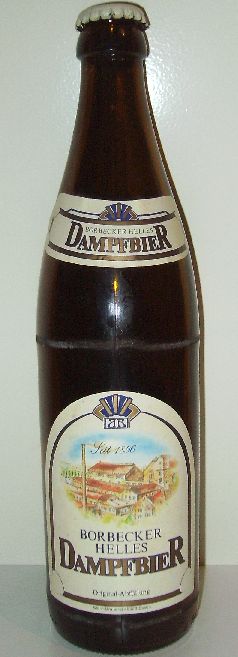Steam beer
Steam Beer[edit | edit source]
Steam beer is a highly effervescent beer brewed using lager yeasts but fermented at warmer ale temperatures. This unique brewing process originated in California during the 19th century and is closely associated with the Anchor Brewing Company in San Francisco.
History[edit | edit source]
The origins of steam beer date back to the California Gold Rush era, when refrigeration was a luxury unavailable to most brewers. The warm climate of California necessitated a different approach to brewing, leading to the development of steam beer. Brewers used lager yeasts, which typically require cooler fermentation temperatures, but allowed the fermentation to occur at higher temperatures, similar to those used for ales.
The name "steam beer" is believed to have originated from the practice of fermenting the beer in open, shallow vessels on rooftops, where the cool night air would help lower the temperature of the fermenting beer. The "steam" may refer to the clouds of steam that rose from the beer as it cooled.
Brewing Process[edit | edit source]
Steam beer is brewed using a process that combines elements of both lager and ale brewing. The key characteristics of steam beer include:
- Yeast: Lager yeast is used, which is typically fermented at cooler temperatures. However, in steam beer production, the fermentation occurs at warmer temperatures, around 18–20°C (64–68°F).
- Fermentation: The warmer fermentation temperatures result in a beer with a distinct flavor profile, often described as having a slightly fruity and robust character.
- Carbonation: Steam beer is known for its high level of natural carbonation, which is achieved through the use of open fermentation vessels and the absence of artificial carbonation methods.
Modern Production[edit | edit source]
Today, the most famous producer of steam beer is the Anchor Brewing Company, which trademarked the term "Steam Beer" in 1981. As a result, other brewers producing similar styles often refer to their products as "California Common" to avoid trademark infringement.
Anchor Steam Beer remains a popular choice among craft beer enthusiasts and is celebrated for its rich history and unique brewing process. The beer is characterized by its amber color, creamy head, and balanced flavor profile, with notes of caramel and a slightly hoppy finish.
Related Pages[edit | edit source]
Search WikiMD
Ad.Tired of being Overweight? Try W8MD's physician weight loss program.
Semaglutide (Ozempic / Wegovy and Tirzepatide (Mounjaro / Zepbound) available.
Advertise on WikiMD
|
WikiMD's Wellness Encyclopedia |
| Let Food Be Thy Medicine Medicine Thy Food - Hippocrates |
Translate this page: - East Asian
中文,
日本,
한국어,
South Asian
हिन्दी,
தமிழ்,
తెలుగు,
Urdu,
ಕನ್ನಡ,
Southeast Asian
Indonesian,
Vietnamese,
Thai,
မြန်မာဘာသာ,
বাংলা
European
español,
Deutsch,
français,
Greek,
português do Brasil,
polski,
română,
русский,
Nederlands,
norsk,
svenska,
suomi,
Italian
Middle Eastern & African
عربى,
Turkish,
Persian,
Hebrew,
Afrikaans,
isiZulu,
Kiswahili,
Other
Bulgarian,
Hungarian,
Czech,
Swedish,
മലയാളം,
मराठी,
ਪੰਜਾਬੀ,
ગુજરાતી,
Portuguese,
Ukrainian
Medical Disclaimer: WikiMD is not a substitute for professional medical advice. The information on WikiMD is provided as an information resource only, may be incorrect, outdated or misleading, and is not to be used or relied on for any diagnostic or treatment purposes. Please consult your health care provider before making any healthcare decisions or for guidance about a specific medical condition. WikiMD expressly disclaims responsibility, and shall have no liability, for any damages, loss, injury, or liability whatsoever suffered as a result of your reliance on the information contained in this site. By visiting this site you agree to the foregoing terms and conditions, which may from time to time be changed or supplemented by WikiMD. If you do not agree to the foregoing terms and conditions, you should not enter or use this site. See full disclaimer.
Credits:Most images are courtesy of Wikimedia commons, and templates, categories Wikipedia, licensed under CC BY SA or similar.
Contributors: Prab R. Tumpati, MD

